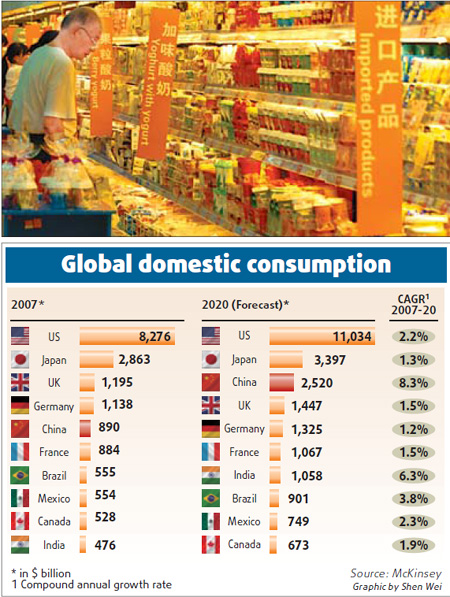China may have an extra domestic consumption worth $1.9 trillion by 2025, if the government adopts more aggressive reform programs covering a wider range of financing policies, job-driven investment projects and a stronger social safety network, according to a report released on Friday by global consultancy firm McKinsey.
These programs, when implemented, will boost the nation's share worldwide to 13 percent, 4 percentage points higher than if without them, and raise the ratio of domestic consumption to China's GDP to 50 percent, said the report.
Despite China's top position as a consumer market worldwide, the nation is still lagging far behind when it comes to the consumption-to-GDP ratio. In 2007, China's domestic consumption totaled $890 billion, making it the fifth-largest consumer market, following the US, Japan, UK and Germany. The nation's consumption-to-GDP ratio of 36 percent, is half that of the US and about two-thirds of Europe and Japan.
"The source of the low consumption is both behavioral and structural," said the report.
Chinese families on an average utilize nearly 25 percent of their income for savings, which is about six times that of US and three times Japan's.
The reason why they are more focused on savings primarily stems from social security concerns. They lack adequate health insurance and cannot fully rely on government- or employer-sponsored programs after retirement, said Chen Yougang, partner, McKinsey & Company.
Better healthcare and pension guarantees alone cannot significantly raise domestic consumption before 2025, said the report.
"The guarantees are important, but the efforts cannot take off until after 2025, and the impact on boosting consumption is the least compared with other factors," Alex Peng, principal of McKinsey & Company said.
Besides the high savings ratio, under-developed infrastructure and not-high-quality products and services deter consumers from spending, said Chen.
In rural areas where half of the Chinese population lives, only 18 percent of the goods could be purchased from organized retail establishments due to the limited retailing network, compared with 50 percent in urban areas.
China should try to "enable consumers to spend" by leveraging a package of methods, such as "direct stimulation" by setting up a wider and more quality sales network, "providing consumers financing channels to buy apartments and to get education," said Peng.
These are the "quickest ways" to improve domestic consumption, he said.
McKinsey estimates that, the measures, when implemented, could raise the ratio of consumption to GDP in 2025 by 2.8 to 4.7 percent.
The Chinese are always hesitant to buy on credit, with the consumer debt standing at 3 percent, well below the developing nations, such as Brazil and Russia at 12 and 7 percent respectively.
In China, only affluent families can obtain mortgages which account for 23 percent of the new properties in the country, whereas it is around 50 percent in the US.
Concerns about higher education are also preventing consumers from spending, with 60 percent of the respondents in agreement.
The most effective but the hardest way to boost consumption is "rebalancing investment and income", said Peng.
For years, State-owned and large companies had easy access to financing, but utilized the same for equipment purchase when they made profits, rather than reward laborers with bonuses or dividends.
"Banks should be encouraged to support the service sector and small- and medium-sized companies, and dividend policies should also be changed. But it will take a long time for that to happen," said Peng.

(China Daily August 22, 2009)